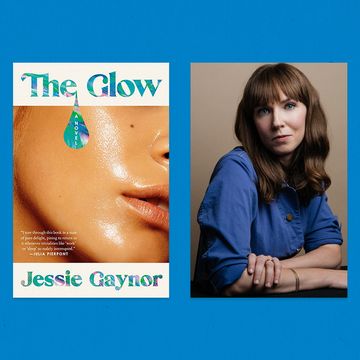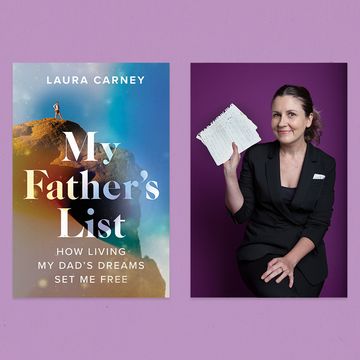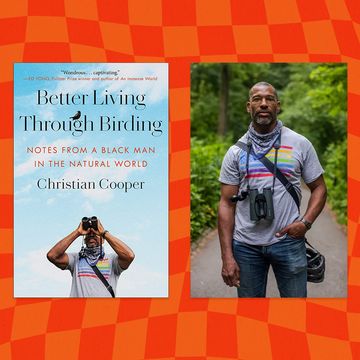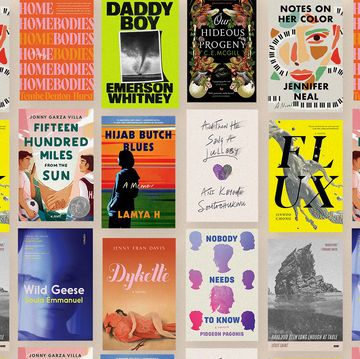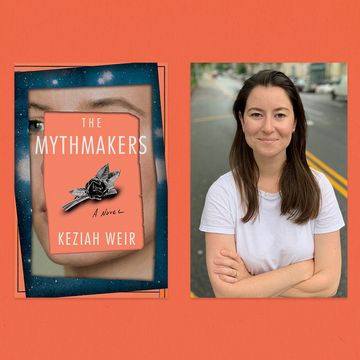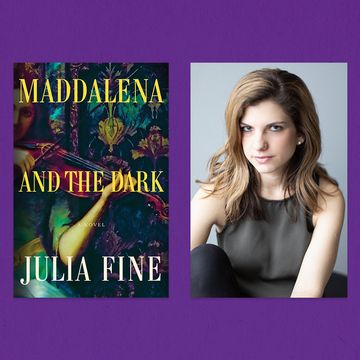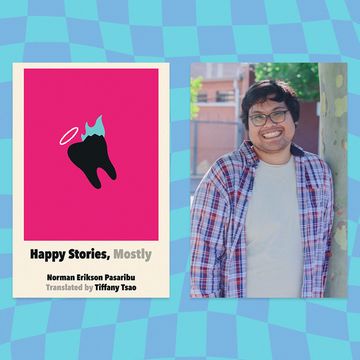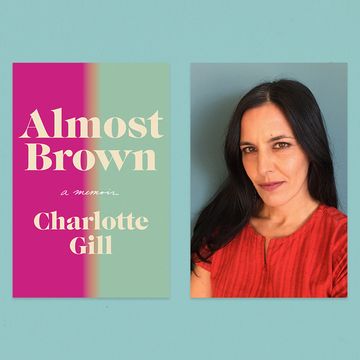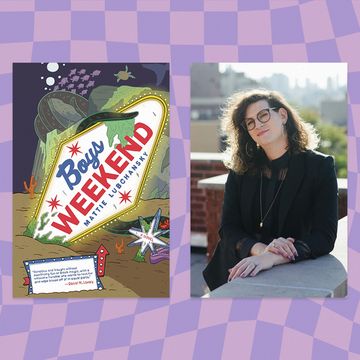Amelia Possanza’s first lifelong love, as she writes in her new book, Lesbian Love Story, is swimming. So when Possanza, a book publicist, moved to New York, she joined an LGBTQ swim team. What she discovered was that the team was mostly made up of gay men. Possanza is clear that she holds no animosity toward these men, but the experience made her think about who is often missing from these and other spaces.
This inspired an interest in unearthing the stories of lesbians of the past, with each chapter in Lesbian Love Story following a different lesbian from a period of history. From Mary Casal in the 1920s, whose memoir The Stone Wall was rumored to have inspired the infamous bar of the same name, to athlete Babe Didrikson Zaharias, Lesbian Herstory Archives co-founder Mabel Hampton, Chicana activists Gloria Anzaldúa and Cherríe Moraga, and even the Greek poet Sappho, this book sings with stories. Possanza fills in gaps in the archival material by imagining scenes in these women’s lives, like the thrill of a kiss. Throughout, the author also includes stories from her own life that enhance this portrait of lesbian life and its myriad meanings. Propulsive and beautiful, Lesbian Love Story is a book true to its name.
Shondaland spoke with Possanza about history and the stories that aren’t documented, living archives, the importance of imagination, and the expansive meaning of lesbian love.
SARAH NEILSON: How did this book come to be, and how did you approach this task you set out for yourself at the start of the book of “collecting lesbians” and deciding which lesbians from which eras you were going to research?
AMELIA POSSANZA: This is a project that’s been with me for a long time, so trying to remember the origins takes me back to pre-pandemic days. In spite of having love in the title, it kind of grew out of a place of anger. I moved to New York City and was surrounded by a lot of gay male culture, monuments, stories, bookstores. I joined an LGBTQ+ swim team, and I was like, “I really am only seeing the G.” I think that that really goes with the stereotype of being a man-hating lesbian. And I was like, “Well, you know what, Amelia? The more mature thing to do would be instead of complaining about this, I want to go find this [story] and have it for myself and share it with other people.” I wish that I could say that I sat down with some sort of March Madness-style grid to decide who gets to be included, but I really went with some of my personal instincts. And that’s a little bit of how I ended up in the story too. I did try and pick someone from almost every decade in the 20th century. This is not the all-inclusive history of lesbians; I could not alone create that. I wanted to be really honest about who I am and how that led me to pick these people. I’m a swimmer, so I felt really drawn to Babe Didrikson because she was an Olympic athlete in track and field, but she was also an incredible golf player. She kind of bragged about being an incredible swimmer; I don’t believe her. So yeah, there was no official selection process; it was me getting lost and gravitating towards certain people. Someone pointed out to me that no one in my book is really a high femme, and that’s definitely the bias of me as the narrator — I’ve never felt like a high femme. I just hope in my nerdiest of hearts that it’s an invitation for other people to do this [research] because I cannot find everyone, and I feel very conscious of what’s missing. Like the high femmes, there aren’t any trans women in here, there aren’t a lot of Asian American women, there are no Indigenous lesbians here. There’s so many more stories, and I could only manage seven.
SN: Can you talk more about when and how it became important for you to look at lesbians and lesbian love across a long period of time, and how you approached engaging with and imagining these different eras?
AP: The different eras happened because when I was asking, “Why don’t I know about lesbian history? What can I learn?,” I did initially stumble upon the lesbian in the first chapter, Mary Casal, in a book about Stonewall. I think of Stonewall as being one of the most written-about moments in the gay liberation movement. I was two pages into this thick tome about Stonewall, and it was like, “We think that it might be named after this lesbian memoir, The Stone Wall by Mary Casal.” So, I picked up the book and started reading it without having to imagine what a full project would be. Because she was living around the turn of the century, which was so much earlier than I think I expected to find someone who was so frank about their own experience, I was asking, “What happened between then and now? Why did I never learn this story? Who came after Mary? How do I fill in the blanks?” I think what’s heartbreaking about her memoir is that for so long she thinks, “I’m the only person with such a nature.” I think that’s her euphemistic way of putting it. To go from there to Stonewall, which in my mind is mainly just this moment when people recognized each other and were like, “Okay, we are all in this together.” Maybe if I had stumbled upon something that was a little later in the timeline, I wouldn’t have had that same question of how did we go from there to here. Sometimes my friends and I, in perhaps a naive way, we talk about when would be the best era to be gay. For a long time, we’ve thought, “Our era, obviously.” I was fascinated by the fact that Mary kind of got away with a lot. At the turn of the century, women were allowed to have these romantic friendships or live in a Boston marriage with another woman. I also had the question of how did we get from that to institutionalizing queer people and giving them shock treatments at Bellevue Hospital in the ’50s?
SN: On this idea of how your subjects imagined this life for themselves and created it, and how you imagined scenes in this life as you were researching, in what ways is that creative license really important not only for filling in archival gaps, but also for creating a queer and community-oriented narrative?
AP: Along the lines of how women “got away with it” in this early period because some people were like, “Oh, they’re just friends; they’re practicing for their future marriage,” I really wanted to focus on instances where to a certain degree, it was irrefutable that this was a romantic and sexual relationship. When I did start this project and I was looking for lesbians to research, people started recommending Eleanor Roosevelt and Emily Dickinson, saying I could write a book about really famous people that we didn’t know were queer. I knew from the start that I don’t want to do that, I think for exactly the reason you touched on. I want people who were so brave to live life and invent life and imagine life the way that they wanted, and who sort of resisted in that daily kind of way, and who left some record saying that this was their life.
After I had done my research and gotten to know things, I wanted to talk to Joan Nestle, the founder of the Lesbian Herstory Archives. We had the most delightful conversation, and I told her that people were asking me, “What were these lesbians famous for? Why are you so interested in them?” And she said, “Oh, for us, having the bravery to touch another woman was fame enough.” I loved that quote because the reasons that history gets made and the people we think of as famous really are centering one kind of lifestyle. We’re commemorating wars, war heroes, presidents. … And even all of these institutions, a lot of the places where I got records to do this research were institutions that were not like, “We’re here to celebrate queer love.” Bedford Hills Correctional Facility was not like, “Let’s keep records about people to celebrate queer love.” Our historical record is already really biased towards certain narratives, and it’s ignoring movements, community organizers, and a lot of working-class people. A lot of the people that I chose do not fit those traditional hero narratives, but for me they’re heroes. They have something much more important to teach me. To bring it full circle with your question about imagining things, part of the reason that I imagined things is that I wanted it to have that richness. I didn’t want it to feel flat with these open questions. So, I admit to what I imagined, and I try to keep it within the realm of what was happening, but I wanted it to have the richness that I think some of these histories [haven’t documented] because it feels like they’re not as rich as, say, WWII.
SN: Can you talk about your research process and your relationship to archives?
AP: In some ways, my process was limited because a lot of it took place during the pandemic. It was a lot more digital research than I expected, but I think it also led me to the fact that I live in New York City, and the city itself is an archive! Rusty Brown [one of the subjects of the book] went to a number of institutions for wayward children, so I just biked over one day, and there was a plaque. And since we only have records of certain things, it’s interesting to go around the city and ask, “What is still here? What are we making monuments to?” I tried to find Mabel Hampton’s house — one of her residences was torn down, and there’s a monument to something else on the street, but there’s no monument to her house. So, it is interesting too to think of my own city as its own archive, and I can go out and find these places — it doesn’t just have to be documents. But in the realm of documents, it’s just so dictated by what was going on at the time. Like, when queerness was documented for the first half of the 20th century, it was often in a newspaper headline because someone was being arrested or someone was being institutionalized, and it was commented on. So, looking at archives for me meant asking two things: “What is this document saying?” and “Can I take that at face value? What was shaping it? Who was doing the archiving? What was their mission?”
SN: The term "lesbian love" — what does it mean to you? What is full of possibility and freedom about this idea?
AP: For me, "lesbian" came to mean a word for someone who was not conforming to the usual script of getting married in a transaction that grants your family status and wealth. I think it was my first time reckoning with the fact that that script, which seems so romantic, actually in society has this history of being about trade and bringing together alliances of wealthy families and passing on your wealth, and a lot of these so-called rights that people are still fighting for are being protected for exactly that reason. The right to marry is protected because we only want to let certain people pass along their wealth or inherit wealth. So, I think lesbians began to be really expressive of rejecting that basic system. And at the end of the day, that’s a system that’s not about “women are good, and men are bad” or “queer people are good, and straight people are bad.” I think it’s a system that harms everyone involved. I think that it’s a trap that we’re all in together. And the word love came to mean to me not just romantic love, but the bravery to live authentically. When it was such a big risk and people were being imprisoned and being threatened with shock treatments, the people in this book continued choosing a life outside that system, and I think they’re an inspiration to all of us. We could all be living outside that system and helping each other out and not tying wealth, inheritance, health care to these very traditional and old-fashioned family ties of marriage and blood relations. Lesbian love came to me almost like the kind of love that exists outside of capitalism — nothing to gain, we’re not necessarily getting married, we’re not necessarily doing the traditional things, but it’s still worthwhile. And I think that’s its own form of resistance.
This interview has been edited for length and clarity.
Sarah Neilson is a freelance culture writer and interviewer whose work regularly appears in The Seattle Times, Them, and Shondaland, among other outlets. They are an alum of the Tin House craft intensive, and their memoir writing has been published in Catapult and Ligeia.
Get Shondaland directly in your inbox: SUBSCRIBE TODAY




